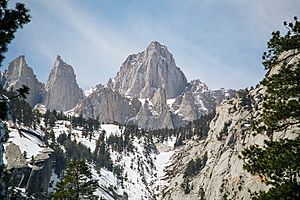List of mountain ranges of California facts for kids

California is a state full of amazing landscapes, and one of the most striking features is its many mountain ranges! These are long chains of mountains that stretch across the land. From the tall, snowy peaks of the Sierra Nevada to the rugged hills along the coast, California has a huge variety of mountains. These ranges are home to many different plants and animals, and they offer incredible places for outdoor adventures.
Contents
What is a Mountain Range?
A mountain range is a group of mountains that are connected. They are usually formed by the same geological processes. Think of them like a long, bumpy spine across the land. Some ranges are very tall and jagged, while others are lower and more rounded.
Why Does California Have So Many Mountains?
California is a very active place geologically. This means the Earth's crust is always moving and changing here. Most of California's mountains were formed by the movement of huge pieces of the Earth's surface called tectonic plates. When these plates push against each other, they can cause the land to fold, crack, and lift up, creating mountains. The famous San Andreas Fault is a big part of this process!
Major Mountain Ranges of California
California's mountains can be grouped into several main systems. Each system has its own unique look and feel.
The Sierra Nevada
The Sierra Nevada is perhaps the most famous mountain range in California. It runs for about 400 miles (640 km) along the eastern side of the state. This range is known for its tall, granite peaks, including Mount Whitney, which is the highest point in the contiguous United States. The Sierra Nevada is also home to beautiful places like Yosemite National Park and Sequoia National Park, famous for their giant trees and stunning valleys.
Some ranges within or connected to the Sierra Nevada include:
The Coast Ranges
The Coast Ranges run along the Pacific Ocean from northern to southern California. These mountains are generally lower and more rounded than the Sierra Nevada. They are often covered in forests, including the famous redwood trees in the north. The Coast Ranges create many valleys and bays, shaping California's beautiful coastline.
Examples of Coast Ranges:
- Berkeley Hills
- Diablo Range
- Gabilan Range
- King Range
- Mayacamas Mountains
- Santa Cruz Mountains
- Santa Lucia Range
- Sonoma Mountains
The Transverse Ranges
The Transverse Ranges are unique because they run east to west, which is unusual for mountain ranges in North America. They are located in Southern California. These ranges include some well-known mountains near major cities.
Examples of Transverse Ranges:
- San Bernardino Mountains
- San Gabriel Mountains
- Santa Monica Mountains
- Santa Susana Mountains
- Tehachapi Mountains
- Topatopa Mountains
The Peninsular Ranges
The Peninsular Ranges stretch from Southern California down into Baja California. These mountains are often rugged and dry, especially on their eastern sides. They are known for their unique desert plants and wildlife.
Examples of Peninsular Ranges:
- Cuyamaca Mountains
- Jacumba Mountains
- Laguna Mountains
- San Jacinto Mountains
- Santa Ana Mountains
- Santa Rosa Mountains
- San Ysidro Mountains
Desert Ranges
Eastern California is home to vast deserts, and within these deserts are many smaller, rugged mountain ranges. These "desert ranges" are often very dry and rocky, with unique plants and animals adapted to the harsh environment. They are part of the Mojave Desert and Colorado Desert.
Examples of Desert Ranges:
- Amargosa Range
- Black Mountains (in Death Valley)
- Chocolate Mountains
- Coso Range
- Funeral Mountains
- Granite Mountains
- Inyo Mountains
- Kingston Range
- Little San Bernardino Mountains
- New York Mountains
- Old Woman Mountains
- Panamint Range
- Providence Mountains
- Rand Mountains
- Resting Spring Range
- Riverside Mountains
- Sheep Hole Mountains
- Silurian Hills
- Slate Range
- Soda Mountains
- Turtle Mountains
- White Mountains
Exploring California's Mountains
California's mountain ranges offer countless opportunities for outdoor activities. You can go hiking, camping, rock climbing, or even skiing and snowboarding in the winter. They are also important for wildlife, providing homes for animals like bighorn sheep, black bears, and many types of birds. Protecting these natural areas helps keep California's unique beauty alive for everyone to enjoy.
See also
- List of mountain peaks of North America
- List of mountain peaks of Greenland
- List of mountain peaks of Canada
- List of mountain peaks of the Rocky Mountains
- List of mountain peaks of the United States
- List of mountain peaks of Alaska
- List of mountain peaks of California
- List of the major 4000-meter summits of California
- List of the major 3000-meter summits of California
- List of California fourteeners
- List of mountain ranges of California
- List of mountain peaks of Colorado
- List of mountain peaks of Hawaiʻi
- List of mountain peaks of México
- List of mountain peaks of Central America
- List of mountain peaks of the Caribbean
- California
- Physical geography
- Topography
- Topographic elevation
- Topographic prominence
- Topographic isolation
- Topography

